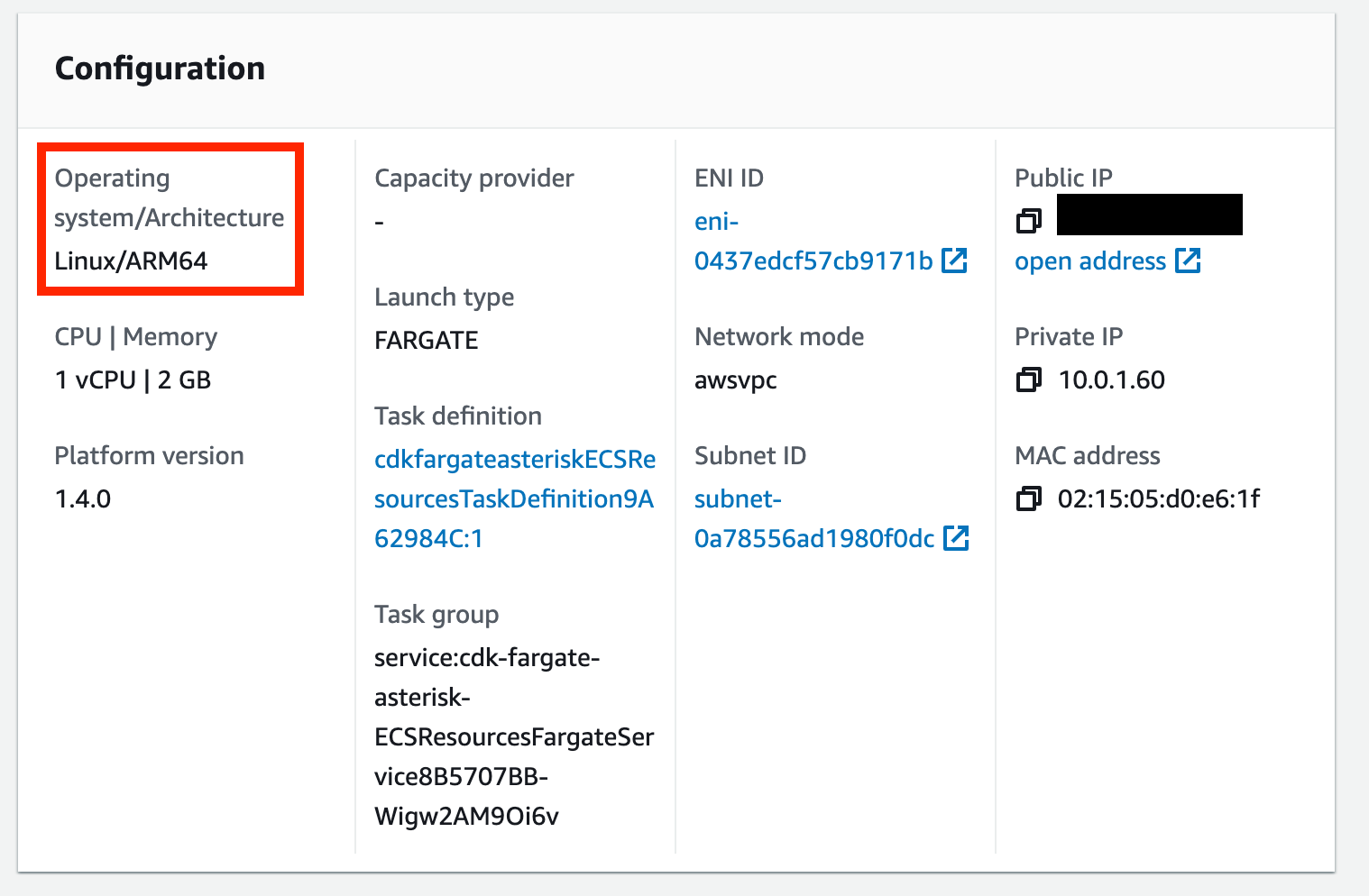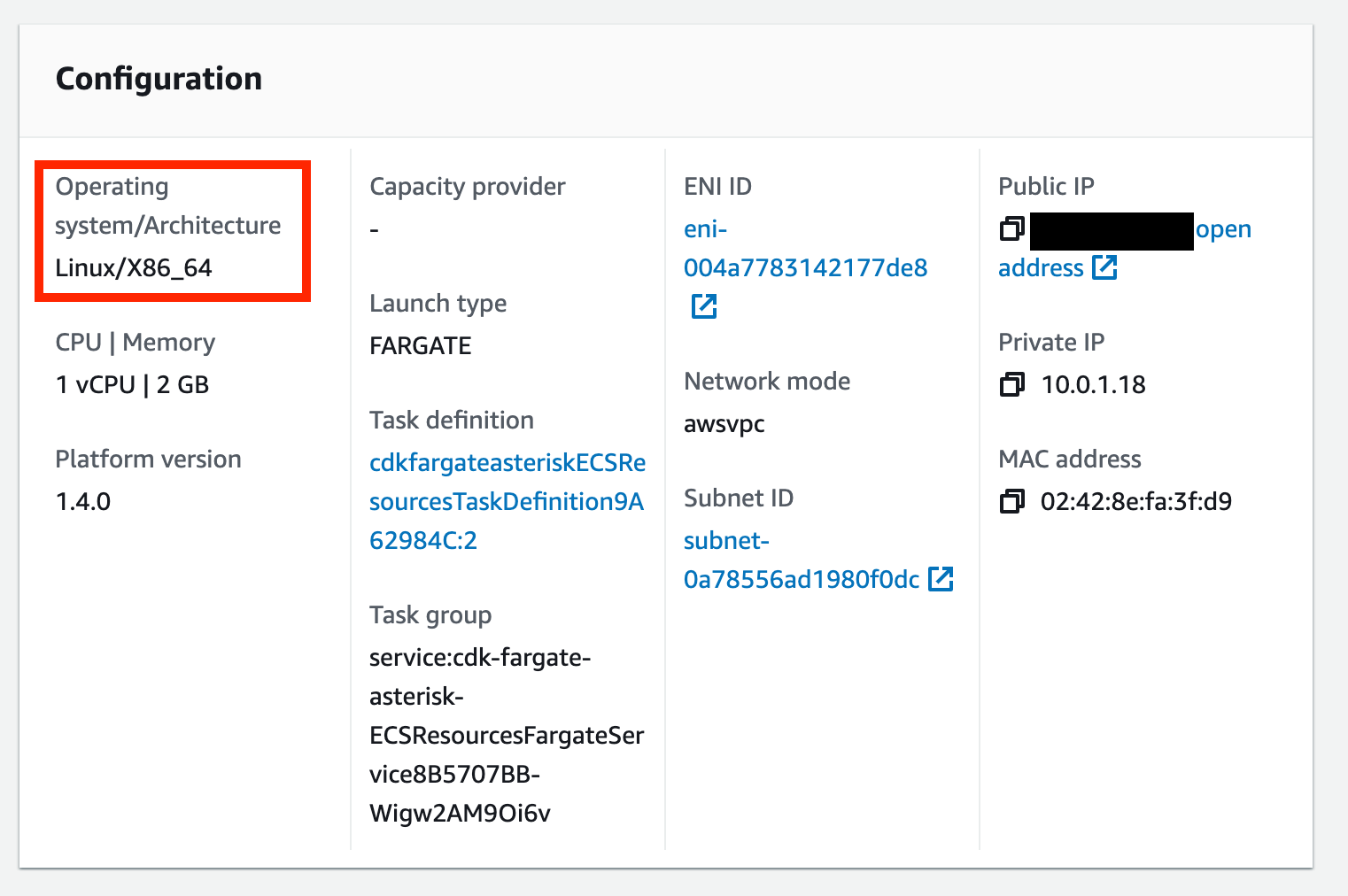Multiple CPU Architecture CDK Deployment of an Asterisk to ECS Fargate
This demo contains a CDK deployment of an Asterisk server to Amazon ECS using Fargate. This will allow us to deploy an Asterisk server to a Docker container.
https://github.com/schuettc/cdk-fargate-asterisk
Docker Image
For this demo, we will be using the andrius/asterisk Docker image.
Asterisk Configuration
To allow for customized configuration, we will copy files from the local directory to the Asterisk server in the Dockerfile.
COPY config/* /etc/asterisk
COPY docker-entrypoint.sh /
RUN chmod +x /docker-entrypoint.sh
In this example, we are copying in several files for our configuration including a pjsip.conf and extensions.conf files.
[udp]
type=transport
protocol=udp
bind=0.0.0.0
external_media_address=PUBLIC_IP
external_signaling_address=PUBLIC_IP
allow_reload=yes
In the pjsip.conf file, we are simply loading a basic udp transport. We will configure this during deployment later.
Multiple Build Platforms
In order to accommodate deployments from multiple platforms, we will ensure that the deployed version matches the built version.
In the Dockerfile we will use ${BUILDPLATFORM} to make sure we're building using the local architecture. We need to do this because we are copying files to the image and then building it before deploying it.
FROM --platform=${BUILDPLATFORM} andrius/asterisk
In the ecs.ts file, we will determine the local architecture and use that.
let deployArch: CpuArchitecture;
const cpuArch = os.arch();
if (cpuArch === "arm64") {
deployArch = CpuArchitecture.ARM64;
} else {
deployArch = CpuArchitecture.X86_64;
}
Then, when we create the Task, we will use that deployArch as part of the build for the cpuArchitecture.
this.task = new FargateTaskDefinition(this, "TaskDefinition", {
memoryLimitMiB: 2048,
cpu: 1024,
runtimePlatform: {
operatingSystemFamily: OperatingSystemFamily.LINUX,
cpuArchitecture: deployArch,
},
taskRole: asteriskTaskRole,
volumes: [
{
name: "asteriskLogs",
efsVolumeConfiguration: {
fileSystemId: fileSystem.fileSystemId,
transitEncryption: "ENABLED",
authorizationConfig: {
accessPointId: asteriskAccessPoint.accessPointId,
iam: "ENABLED",
},
},
},
],
});
Now the deployed version will match the locally built version.
For example, when the Docker image is built on an M1 Mac, the Architecture type will be ARM64.

However, if the Docker image is built on an X86 based CPU, the Architecture type will be X86_64.

Access the Asterisk Server
Once deployed, the Asterisk server can be accessed using ecs-execute
Included in the output of the CDK will be several commands that can be copied to the terminal for ssh access.
To access the running Asterisk:
- Copy/paste the
CLUSTER=command - Copy/paste the
TASK=command - Copy/paste either
aws ecs execute-commandcommand
Asterisk Configuration
During deployment of the Fargate container, the Dockerfile will use docker-entrypoint.sh as it's ENTRYPOINT. Everything in that file will be executed. We can use this to configure the Asterisk during deployment.
echo "METADATA: " ${ECS_CONTAINER_METADATA_URI_V4}
curl -o metadata.json ${ECS_CONTAINER_METADATA_URI_V4}/task
cat metadata.json
TASK_ARN=$( curl ${ECS_CONTAINER_METADATA_URI_V4}/task | jq -r '.TaskARN' )
echo "TASK_ARN: " $TASK_ARN
CLUSTER=$( curl ${ECS_CONTAINER_METADATA_URI_V4}/task | jq -r '.Cluster' )
echo "CLUSTER: " $CLUSTER
ENI=$(aws ecs describe-tasks --tasks $TASK_ARN --cluster $CLUSTER | jq -r '.tasks[0].attachments[0].details[1].value' )
echo "ENI: " $ENI
PUBLIC_IP=$( aws ec2 describe-network-interfaces --network-interface-ids $ENI | jq -r '.NetworkInterfaces[0].Association.PublicIp' )
echo "PUBLIC_IP: ${PUBLIC_IP}"
sed -i "s/PUBLIC_IP/$PUBLIC_IP/g" /etc/asterisk/pjsip.conf
With this shell script, we will determine the PUBLIC_IP of the container that is running and use that to configure the pjsip.conf file. This can be expanded to configure other parts of the Asterisk server as needed.
Deploy/Destroy
To deploy this demo:
yarn launch
To destroy this demo:
yarn cdk destroy
